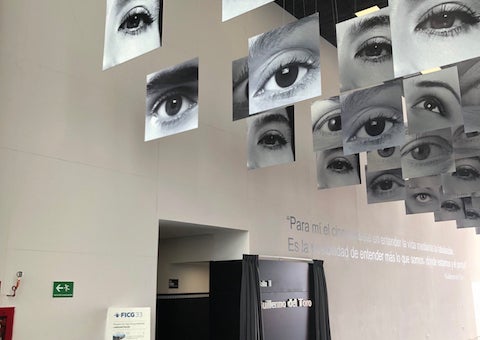
I first met Iván Trujillo Bolio about 30 years ago at a FIAF Congress (International Federation of Film Archives), when he was the director of the Filmoteca UNAM and I was at Eastman Museum. In the 1990s, we worked very closely together, when we were the young Turks on FIAF’s Executive Committee. We reconnected at the last FIAF Congress in Los Angeles, where Trujillo first mentioned plans for a new Cineteca in Guadalajara. Those plans have come to fruition at this year’s Guadalajara International Film Festival (March 9-16). Along with a number of other colleagues from international film archives, I was invited to an opening event with the Cineteca’s young staff.
I arrived in Guadalajara a few days after the Festival opened. Among my film archive colleagues, I was happy to see Robert Daudelin (formerly at Cinémathèque québécoise), José Manuel Costa (Cinemateca Portuguese), Chema Prado (formerly at Filmoteca Espagñola), as well as our Mexican archive partners Viviana Garcia Besné (Permanencia Voluntaria), Alejandro Pelayo (Cineteca Nacional, Mexico), and Hugo Villa Smythe (newly named Director General of the Filmoteca UNAM). After a discussion about the work of international film archives and their preservation strategies, I was curious to learn, what were the actual plans for the new Cineteca?
To find out, I drove out to the Cineteca, which is located somewhat outside the city center in a newly constructed complex at the University of Guadalajara. After walking around the mostly still-empty building of the Cineteca, I visited a travelling exhibition honoring “50 Years of the Sitges Film Festival” in one of the galleries next to the Guillermo del Toro theater. I quickly realized that the Cineteca was still very much a work in progress. Happily, I was able to catch Cineteca Director Iván Trujillo Bolio for a short interview about their current plans.
 The most important fact I learned was that the Guadalajara Film Festival, now in its 33rd year, will be organized and operated by the Cineteca. And while Trujillo noted that the Cineteca will program film and video screenings in its new space throughout the year, the Festival will be their most important event. The Festival has made a name for itself programming mostly new films from Mexico and the rest of Latin America and the Iberian Peninsula, and is very popular with local audiences. This year also included a small group of classic cabaret films, but attendance was very light at the screening of Alberto Gout’s Sensualidad (1951). Nevertheless, Trujillo hopes to expand the retrospective program, although he is still uncertain whether they will follow the model of Bologna, which shows a broad palette of classic films or San Sebastián, which focuses on single directors or genres. The inclusion of a retrospective program at the Festival is also connected to the Cineteca’s archive plans.
The most important fact I learned was that the Guadalajara Film Festival, now in its 33rd year, will be organized and operated by the Cineteca. And while Trujillo noted that the Cineteca will program film and video screenings in its new space throughout the year, the Festival will be their most important event. The Festival has made a name for itself programming mostly new films from Mexico and the rest of Latin America and the Iberian Peninsula, and is very popular with local audiences. This year also included a small group of classic cabaret films, but attendance was very light at the screening of Alberto Gout’s Sensualidad (1951). Nevertheless, Trujillo hopes to expand the retrospective program, although he is still uncertain whether they will follow the model of Bologna, which shows a broad palette of classic films or San Sebastián, which focuses on single directors or genres. The inclusion of a retrospective program at the Festival is also connected to the Cineteca’s archive plans.
Trujillo told me they are hoping to join FIAF as an Associate member. However, they are not planning to establish an analog film archive, but will instead deposit the 35mm and 16mm films they collect at one of the established Mexican film archives. Instead, they will create a regional digital film archive. They are also hoping to work with international film archive partners to preserve selected classic films, which they plan to premiere at the Festival. For example, the Cineteca recently found the “lost” Mexican classic, Doña Herlinda and Her Son (dir. Jaime Humberto Hermosillo, 1985), which, despite its relative young age and its huge popularity, had disappeared. A print and the original 16mm were found with a distributor who had bought the rights to the film after the initial rights expired, and will now be restored digitally in conjunction with a Mexican film archive. In the future, the Cineteca wants to find other lost or damaged Mexican features, and one can only hope they will succeed in preserving their national film patrimony.
< Back to Archival Spaces blog






 Mobile Navigation
Mobile Navigation

